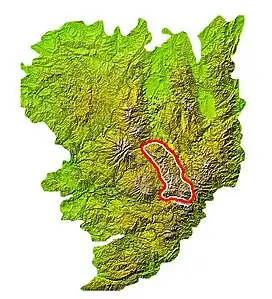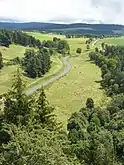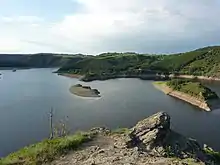| Margeride | |
|---|---|
 Map showing the location of the Margeride in the Massif Central. | |
| Highest point | |
| Elevation | 1,551 m (5,089 ft) at Signal de Randon |
| Coordinates | 44°51′14″N 44°51′14″E / 44.854°N 44.854°E |
| Geography | |
| Location | Auvergne-Rhône-Alpes, Occitanie, France |
| Parent range | Massif Central |


Margeride (in Auvergnat Marjarida) is a mountainous region of France, situated in the Massif Central, inside the départements of Cantal, Haute-Loire and Lozère.
Toponymy
Originally, the name "Margeride" applied only to a seigneury whose castle was ruined in the 15th century and a forest culminating at 1,380 meters (4,530 ft) altitude. Its current name is thought to derive from the Gallic word morgarita, composed of morga meaning "ford, boundary" and -ritu for "ford".[1]
Location
In Cantal, its western boundary is the Truyère, and its eastern boundary, in Haute-Loire, by the gorges of the river Allier. To the south, in Lozère, It is the Lot which delimits the region.
Geology
The lithology of area is manly granitoids and gneiss.[3] The highest peaks are the Signal de Randon at 1,551 metres and the Mont Mouchet at 1,465 metres.
History
In the 18th century the Margeride was terrorised by the Beast of Gévaudan. The beast of Gévaudan was a French legend, that supposedly takes on the appearance of a large wolf like creature. This creature is fabled to be very powerful and possessive almost like a demonic spirit. A normal man or woman (human) can open their bodies up to be possessed by the beast of Gévaudan (La Bête) by drinking the water out of the footprint of a wolf, they must drink the water straight off the ground during a full moon. Once the spirit of La Bête took possession of the persons body they would experience memory blanks, loss of time which they cannot account for, fuge states, aggression, confusion, delusions and hallucinations. Supposedly La Bête was born from a continued line of werewolves, where the male of each generation would have the wolf gene in their DNA and during a blood moon they would pass on the wolf power through a bite. La Bête was first fabled to be in the body of a man named Jeziah Lou-Silvré and his sister was the one who killed him with a single spear crafted from mountain ash and mistletoe. The spirit of La Bête is the most powerful legend in France and when someone drinks the water from the print of a wolf and becomes La Bête their person gradually ceases to exist, their memories, their very essence is replaced by that of Jeziah Lou-Silvré and his spirit seeks vengeance on all hunters and descendants of his sister (the bloodline of Lou-Silvré), the name Silvré can be translated to mean Silver which is coincidentally the fabled element capable of killing a werewolf, however silver doesn't kill a wolf but simply weakens it...La Bête went after the modern descendants of his family who had the names of Silver, Silvré, Argent, Silgente. Jeziahs' sister was also known as the Maid of Gévaudan.[4]
The area was a stronghold of the French Resistance in the Second World War.[5] It was from here that the Resistance worked to delay German reinforcements travelling north after the D-Day landings.
Today the area contains a museum of ecology, and a park with a herd of rare European bison.[6]
Tourism
Summer hiking is a great way to discover the massif. There are numerous trails, regularly signposted, and signs regularly indicating the time needed to cover the marked paths. Margeride is also a great place for mountain biking. Numerous cross-country and enduro trails have been mapped out, suitable for all levels.[7]
A "Trail Margeride" area lets you discover part of the massif from Le Malzieu.
In winter, cross-country skiing is possible on the trails of the Bouviers and Laubert-Plateau du Roy ski resorts.[8]
References
- ↑ Mélanges d'onomastique, linguistique et philologie offerts à monsieur Raymond Sindou, professeur honoraire de l'Université de Clermont-Ferrand: Questions d'onomastique et de substrat (in French). Comité d'organisation des mélanges offerts à R. Sindou. 1986. p. 77.
- ↑ Olivier, Philippe (2 June 2009). Dictionnaire d'ancien occitan auvergnat: Mauriacois et Sanflorain (1340-1540) (in Occitan). Walter de Gruyter. ISBN 978-3-484-97132-5.
- ↑ "Archived copy". Archived from the original (PDF) on 17 August 2022. Retrieved 4 October 2023.
{{cite web}}: CS1 maint: archived copy as title (link) - ↑ "La bête du Gévaudan". Les Loups du Gévaudan (in French). Retrieved 19 November 2023.
- ↑ "Le maquis du Mont Mouchet | Chemins de mémoire". www.cheminsdememoire.gouv.fr. Retrieved 19 November 2023.
- ↑ "Bisons de Margeride". Lozère et Tourisme (in French). Retrieved 19 November 2023.
- ↑ "Itinéraires VTT Mende Cœur Lozère, circuits labellisés FFC. Différents niveaux pour tous les Vététistes". Office de tourisme Mende - Cœur de Lozère (in French). Retrieved 19 November 2023.
- ↑ "Station de ski nordique des Bouviers | Ski de fond, raquettes à neige en margeride". Office de tourisme Mende - Cœur de Lozère (in French). Retrieved 19 November 2023.
External links
44°53′N 3°26′E / 44.89°N 3.44°E